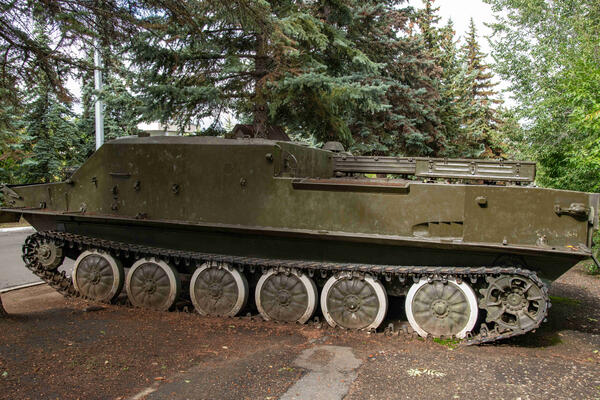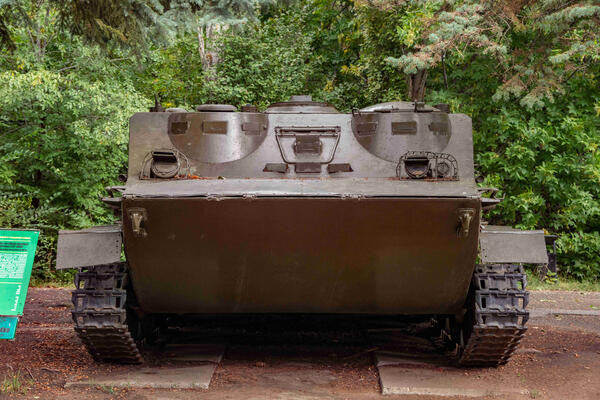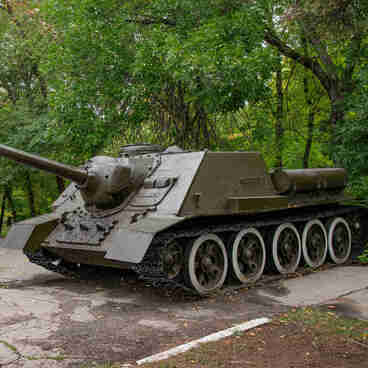The BTR-50PU command and control vehicle was developed at the Kirov Plant in Chelyabinsk on the basis of the BTR-50P amphibious tracked armored personnel carrier. The exterior design remained basically the same as that of the prototype.
The BTR-50PU entered service in 1958. The developers fitted the staff compartment with special equipment. It was used by the commander of the unit, three staff officers and four radio operators. The armored hull of the vehicle was divided into three compartments: the control, staff and engine sections.
The side plates of the hull did not have vision ports, and the fans were transferred from the sides to the roof of the staff compartment, the back wall of which was solid, without a folding plate. A telescopic antenna mast was attached to it in the stowed position.
A rotating turret for a 360-view with a TPKU-2B surveillance device was installed on the roof of the staff compartment. Behind the turret, there were two escape hatches with hinged covers and a porthole, which could be closed with an armored cover. The porthole ensured the crew’s capacity to operate in daytime without artificial lighting.
Three seats were installed in the control room. One was for the commander of the unit (or a formation), the other two for the driver and navigator. There was a communication center in the staff compartment of the vehicle. It included a system of radio relay and wired devices. Two sets of the R-120 intercom were used for internal communication between the crew members of the BTR-50PU.
The vehicle was also fitted with navigation equipment: a course sensor, a DP position reference sensor and a KP-2M1 course plotter. To ensure the operational integrity of radio stations and navigation equipment, the vehicle was fitted with four batteries, a portable petrol-electric charging unit, and five spare batteries.
The command vehicle was fitted with a filter-ventilation unit, equipment for using thermal effects protective smoke screens, an automatic fire extinguishing system and a heater in the staff compartment. A sliding table for working with maps was installed in the middle part of the staff department.
The crew of the BTR-50PU consisted of nine soldiers. Subsequently, the BTR-50PU command vehicle was repeatedly upgraded, mainly due to changes in the components of equipment, which led to the development of the BTR-50PUM and BTR-50PUM1 vehicles.
The BTR-50PU entered service in 1958. The developers fitted the staff compartment with special equipment. It was used by the commander of the unit, three staff officers and four radio operators. The armored hull of the vehicle was divided into three compartments: the control, staff and engine sections.
The side plates of the hull did not have vision ports, and the fans were transferred from the sides to the roof of the staff compartment, the back wall of which was solid, without a folding plate. A telescopic antenna mast was attached to it in the stowed position.
A rotating turret for a 360-view with a TPKU-2B surveillance device was installed on the roof of the staff compartment. Behind the turret, there were two escape hatches with hinged covers and a porthole, which could be closed with an armored cover. The porthole ensured the crew’s capacity to operate in daytime without artificial lighting.
Three seats were installed in the control room. One was for the commander of the unit (or a formation), the other two for the driver and navigator. There was a communication center in the staff compartment of the vehicle. It included a system of radio relay and wired devices. Two sets of the R-120 intercom were used for internal communication between the crew members of the BTR-50PU.
The vehicle was also fitted with navigation equipment: a course sensor, a DP position reference sensor and a KP-2M1 course plotter. To ensure the operational integrity of radio stations and navigation equipment, the vehicle was fitted with four batteries, a portable petrol-electric charging unit, and five spare batteries.
The command vehicle was fitted with a filter-ventilation unit, equipment for using thermal effects protective smoke screens, an automatic fire extinguishing system and a heater in the staff compartment. A sliding table for working with maps was installed in the middle part of the staff department.
The crew of the BTR-50PU consisted of nine soldiers. Subsequently, the BTR-50PU command vehicle was repeatedly upgraded, mainly due to changes in the components of equipment, which led to the development of the BTR-50PUM and BTR-50PUM1 vehicles.




